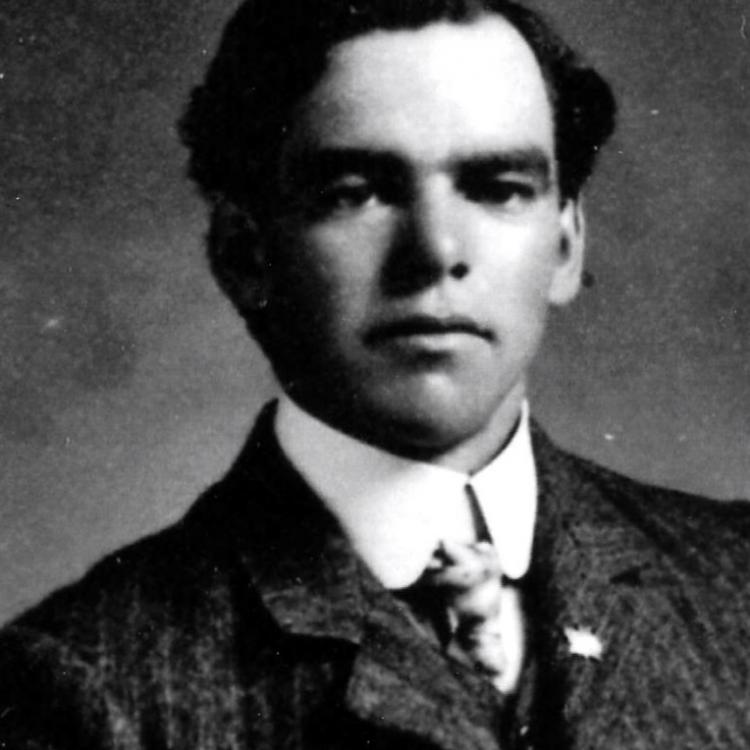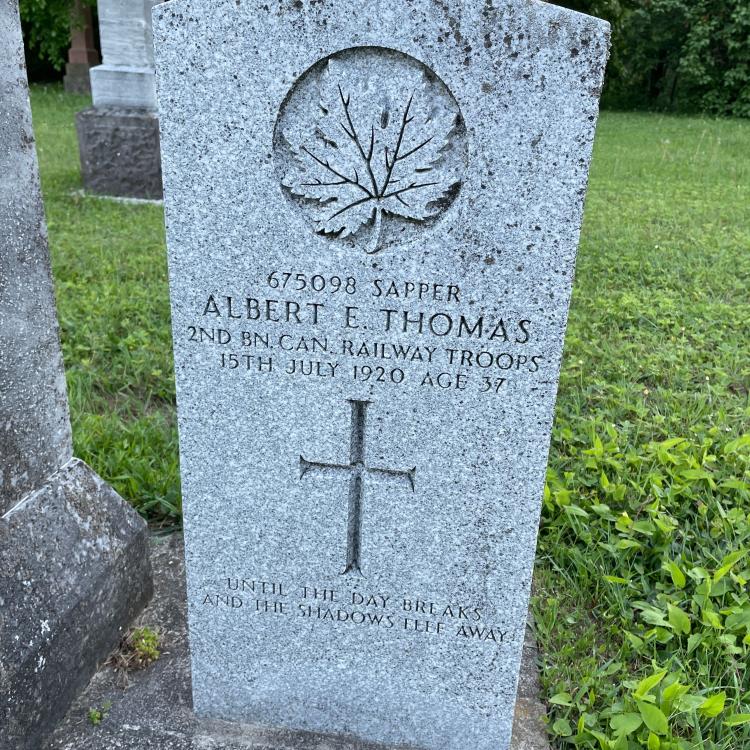THOMAS, Albert Edward
Next of Kin: Phillip Thomas, Bluevale, Ontario
Occupation: Farmer/Carpenter
Personal Details: 5 ft. 9 in., 180 lbs., dark complexion, grey eyes, black hair, Presbyterian
Albert “Bert” Edward Thomas was one of eight children born to parents, Philip and Elizabeth Thomas. He grew up in Turnberry Township, where he helped out with the farm work and learned carpentry skills. In 1906, he married Bertha Churchill, and together they started their family on a neighbouring farm they had rented. Bertha died suddenly of a burst appendix in February 1915, leaving Bert with four young children to raise, Roy Burt, 8, Robert “Harold”, 7, Joseph “Mac” MacKenzie, 5, and Pearl “Lavina” Elizabeth, 3. In June 1915 The Wingham Times reported he had auctioned his farm stock and implements. Bert left his children in the care of his parents and travelled to London, Ontario to enlist with the 33rd Battalion. Records show that Bert left the 33rd a month later, and was officially declared a deserter in July 1915.
In January 1916 Bert re-enlisted, this time in Woodstock with the 168th Battalion, “Oxford’s Own.” His service record shows he had an interaction with the Military Police in April, probably related to his former desertion, but it appears no further action was taken. He was granted furlough from April 23rd to May 9th, likely to return to the farm for spring planting season. Upon his return he was transferred to the 4th Pioneer Battalion, a unit mobilized at St. Andrews, New Brunswick, but made up of recruits from Ontario, Quebec, Nova Scotia and New Brunswick. The Battalion embarked Halifax on September 12, 1916 aboard the S.S. Metagama, and disembarked in Liverpool on September 22nd.
The Battalion was redesignated the 5th Canadian Pioneer Battalion in November 1916, and absorbed by the Canadian Pioneer Training Depot at Crowborough in December 1916. Subsequently, Sapper Thomas was transferred to the Canadian Railway Construction Corps and proceeded to France, landing at Havre on January 13, 1917. In early February the unit was redesignated the 2nd Battalion Canadian Railway Troops. This Corps of railwaymen were responsible for the construction and maintenance of railways of various gauges, which transported valuable war materials to within easy reach of the Front Line. In January 1917, the war diaries reported the Battalion was engaged in laying and repairing track in the areas around Albert and Bapaume, France, until they were ordered to move to the Ypres, Belgium area at the beginning of June.
Sapper Thomas was admitted to a Field Ambulance on June 27, 1917 with a fever. His illness persisted and he was admitted to No. 10 Stationery Hospital, St. Omer on July 1st. Hospital Ship St. David transported him back to England where he was admitted to the Military Hospital, Herne Bay, Kent, on July 11th. In August he received care at the Military Hospital at Shorncliffe, and the Canadian Convalescent Hospital, Monks Horton, Kent, where a diagnosis of trench fever was eventually made. After two months of treatment he was transferred to No. 4 Canadian General Hospital, Basingstoke, where a medical report said Sapper Thomas looked older than his age. He was discharged from hospital to the Canadian Railway Troops Depot on November 20, 1917.
On December 11, 1917, Bert Thomas was granted permission to marry Emily Kate Austin, a nurse. It is likely that they met while Bert was a patient in hospital. They welcomed a son, Arthur “Bernard” Thomas, and Emily was made Bert’s next-of-kin and received a portion of his assigned pay, with the remainder going to his sister Aggie who was caring for his four children back in Bluevale. Their time together was short, as Bert was shipped back to France to his unit on January 15, 1918.
A little more than a week after his arrival, Sapper Thomas was admitted to No. 112 Field Ambulance on January 24, 1918, with symptoms diagnosed as “myalgia” – a medical term used to describe muscle pain. He was sent to No. 55 Casualty Clearing station four days later, and then admitted to No. 5 General Hospital at Rouen, France on February 1st. On February 13th he was invalided back to England aboard A.T. (Ambulance Transport) Aberdonian, and admitted to Northamptonshire War Hospital, Duston North, two days later. According to the November 7, 1918 edition of The Wingham Advance, the channel crossing was an eventful one, “…during the trip across the channel, the steamer just ahead of the vessel in which Thomas was crossing, was torpedoed by an enemy submarine. The passengers on the torpedoed boat were transferred to the second vessel with the result that the overloaded craft capsized, Thomas was thrown into the water where he lost consciousness. He never knew how or when he was rescued from the water.”
After some months’ recovery, Sapper Thomas was transferred to the Canadian Red Cross Special Hospital, Buxton, on May 24, 1918 with arthritis. As a ‘special’ hospital, patients were admitted with a range of conditions, including rheumatic fever, myalgia, arthritis, osteitis (inflammation of the bone), gout, heart disease, and shell shock. Treatments included swimming, warm mineral and vapour baths, massage, mechanical vibration, high frequency apparatus and radiant heat. One of the doctors on staff was Frederick G. Banting, who would return to Canada after the war to continue his research into diabetes and the use of insulin as a treatment.
Medical reports in Sapper Thomas’ service record showed a review of his related medical history, including that his mother had rheumatism, his father had lumbago, and he had rheumatic fever prior to enlisting. He was kicked by a mule between the shoulders in April 1917, and suffered a shrapnel wound to the head three weeks later, but was not off duty. In early June 1917 he was working in the Battalion’s Blacksmith Shop, but was removed to lighter work because he had pain in all his joints. In addition to being diagnosed with Trench Fever in the summer of 1917, he continued to suffer from pain in his hips, legs, shoulders, neck and arms. A medical review board recommended he be invalided back to Canada, and on September 24, 1918, Sapper Thomas boarded troopship S.S. Khyber and began his journey back home.
Arriving in Halifax on October 7th, Bert was posted to the Hospital Section at Brant Military Hospital, Burlington, Ontario. He was granted leave from October 8th to 22nd, and Bert likely used this time to reunite with his family. His wife Emily, and their baby son followed shortly after, arriving in New York in November 1918. Bert underwent a medical review on December 2nd and was found to have a partial loss of his joint and digestive systems. The medical board deemed him unfit for service at home or abroad, and Bert was formally discharged from service on December 12, 1918.
Bert died on July 15, 1920 at Davisville Hospital, Toronto, Ontario. His death record indicates he had undergone surgery on December 20, 1919, but ultimately died of rectal cancer, exacerbated by diphtheria, which he had suffered from over the last 24 days of his illness. The Wingham Advance reported that Bert contracted diphtheria after being admitted to hospital where he was being treated for the affects of being gassed while overseas.



